 El Grito de Sunset Park gathering in 2016 | |
| Formation | c. 2002 |
|---|---|
| Type | 501(c)(3) organization |
| Location | |
| Website | www |
El Grito de Sunset Park is a Puerto Rican activist organization in Brooklyn [1] [2] that has been described as a police watchdog. [3]
 El Grito de Sunset Park gathering in 2016 | |
| Formation | c. 2002 |
|---|---|
| Type | 501(c)(3) organization |
| Location | |
| Website | www |
El Grito de Sunset Park is a Puerto Rican activist organization in Brooklyn [1] [2] that has been described as a police watchdog. [3]

One of the founders of El Grito de Sunset Park is Dennis Flores, a "cop watcher" who began documenting the activities of the New York Police Department in 1995. [2] [4] [5] He has been arrested more than 70 times for his activities. [4] Flores and others founded El Grito de Sunset Park in 2002, before filming police activities was common. [5] According to Flores, the organization was founded with a $270,000 settlement he received after the police attacked him in 2002. [6] The group became a 501(c)(3) organization in 2015. [7]
The organization has roots in the primarily Puerto Rican neighborhood of Sunset Park in Brooklyn. The name "El Grito" means "the cry" or "the call" in Spanish, and is a reference to the independence movements El Grito de Lares in Puerto Rico and El Grito de Dolores in Mexico. [8] El Grito de Sunset Park has ties to the Young Lords, a Puerto Rican radical group. [1] The group's founders were influenced by social movements in Latin America; Flores witnessed organizing efforts in the Mexican city of Oaxaca in 2006 and 2007, while Jason Del Aguila, also a cofounder, worked for some time in Guatemala and El Salvador. [9]
El Grito de Sunset Park's activities include organizing an art festival; advocating against gentrification; and photographing police activities. [8] When it began, the organization would film police responses to the Puerto Rican Day Parade, which were sometimes violent. Eventually, the group began to film all year. [5] In 2012, the group supported a rent strike in Sunset Park. Hispanic music and spoken word poetry are commemorated in videos made by El Grito de Sunset Park. [10] In 2015, the group began organizing its own Puerto Rican Day Parade and Festival. [11] It worked to gather and send supplies to Puerto Rico in the aftermath of Hurricane Maria in 2017. [8] In 2014, one of the group's videos played a role in charges against a teenage resident of Sunset Park getting dropped, [12] while in 2015 another helped get charges dropped against a Mexican street vendor accused of attacking a policeman. [5]

The Ponce massacre was an event that took place on Palm Sunday, March 21, 1937, in Ponce, Puerto Rico, when a peaceful civilian march turned into a police shooting in which 19 civilians and two policemen were killed, and more than 200 civilians wounded. None of the civilians were armed and most of the dead were reportedly shot in their backs. The march had been organized by the Puerto Rican Nationalist Party to commemorate the abolition of slavery in Puerto Rico by the governing Spanish National Assembly in 1873, and to protest the U.S. government's imprisonment of the Party's leader, Pedro Albizu Campos, on sedition charges.
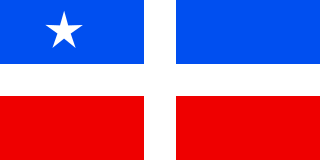
El Grito de Lares, also referred to as the Lares uprising, the Lares revolt, the Lares rebellion, or the Lares revolution, was the first major revolt against Spanish rule in Puerto Rico. The revolt was planned by Ramón Emeterio Betances and Segundo Ruiz Belvis. It began on September 23, 1868 in the town of Lares, for which it is named. It spread rapidly to various revolutionary cells throughout the island.
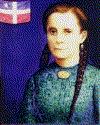
Mariana Bracetti Cuevas (1825–1903) was a patriot and leader of the Puerto Rico independence movement in the 1860s. She is attributed with having knitted the flag that was intended to be used as the national emblem of Puerto Rico in its attempt to overthrow the Spanish government on the island, and to establish the island as a sovereign republic. The attempted overthrow was the Grito de Lares, and Bracetti's creation became known as "The Flag of Lares." The flag's design was later adopted as the official flag of the municipality of Lares, Puerto Rico.

Throughout the history of Puerto Rico, its inhabitants have initiated several movements to obtain independence for the island, first from the Spanish Empire from 1493 to 1898 and since then from the United States.

Lolita Lebrón was a Puerto Rican nationalist who was convicted of attempted murder and other crimes after carrying out an armed attack on the United States Capitol in 1954, which resulted in the wounding of five members of the United States Congress. She was released from prison in 1979 after being granted clemency by President Jimmy Carter. Lebrón was born and raised in Lares, Puerto Rico, where she joined the Puerto Rican Liberal Party. In her youth she met Francisco Matos Paoli, a Puerto Rican poet, with whom she had a relationship. In 1941, Lebrón migrated to New York City, where she joined the Puerto Rican Nationalist Party, gaining influence within the party's leadership.

The Nationalist Party of Puerto Rico is a Puerto Rican political party founded on September 17, 1922, in San Juan, Puerto Rico. Its primary goal is to work for Puerto Rico's independence. The Party's selection in 1930 of Pedro Albizu Campos as its president brought a radical change to the organization and its tactics.
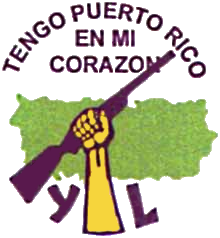
The Young Lords, also known as the Young Lords Organization (YLO) or Young Lords Party (YLP), was a Chicago-based street gang that became a civil and human rights organization. The group aims to fight for neighborhood empowerment and self-determination for Puerto Rico, Latinos, and colonized people. Tactics used by the Young Lords include mass education, canvassing, community programs, occupations, and direct confrontation. The Young Lords became targets of the United States FBI's COINTELPRO program.

The Jayuya Uprising, also known as the Jayuya Revolt or El Grito de Jayuya, was a Nationalist insurrection that took place on October 30, 1950, in the town of Jayuya, Puerto Rico. The insurrection, led by Blanca Canales, was one of the multiple insurrections that occurred throughout Puerto Rico on that day against the Puerto Rican government supported by the United States. The insurrectionists were opposed to US sovereignty over Puerto Rico.

Puerto Ricans have both immigrated and migrated to New York City. The first group of Puerto Ricans immigrated to New York City in the mid-19th century when Puerto Rico was a Spanish colony and its people Spanish subjects. The following wave of Puerto Ricans to move to New York City did so after the Spanish–American War in 1898. Puerto Ricans were no longer Spanish subjects and citizens of Spain, they were now Puerto Rican citizens of an American possession and needed passports to travel to the Contiguous United States.

The Puerto Rican Day Parade takes place annually in the United States along Fifth Avenue in the Manhattan borough of New York City. The parade is held on the second Sunday in June, in honor of the 3.2 million inhabitants of Puerto Rico and all people of Puerto Rican birth or heritage residing on the U.S. mainland. The parade attracts many celebrities, both Puerto Rican and of Puerto Rican heritage, and many politicians from the Tri-State area.
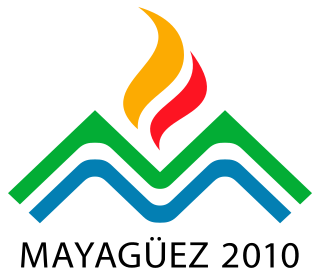
The 21st Central American and Caribbean Games took place in Mayagüez, Puerto Rico, from 18 July 2010 to 1 August 2010.

Paseo Boricua is a section of Division Street in the Humboldt Park community of the West Side of Chicago, Illinois.
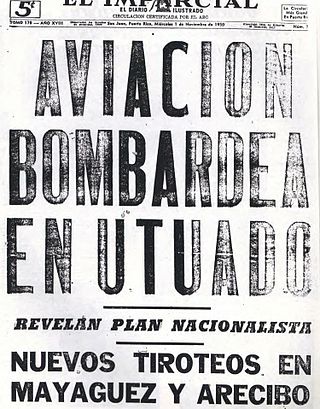
The Utuado uprising, also known as the Utuado revolt or El Grito de Utuado, refers to the revolt against the United States government in Puerto Rico which occurred on October 30, 1950, in the town of Utuado. There were simultaneous revolts in various other towns in Puerto Rico, including the capital of San Juan and the cities of Mayaguez and Arecibo, plus major confrontations in the city of Ponce and the towns of Peñuelas and Jayuya.

The San Juan Nationalist revolt was one of many uprisings against United States Government rule which occurred in Puerto Rico on October 30, 1950 during the Puerto Rican Nationalist Party revolts. Amongst the uprising's main objectives were an attack on La Fortaleza, and the U.S. Federal Court House Building in Old San Juan.

The Intentona de Yauco of March 1897 was the second and final major revolt against Spanish colonial rule in Puerto Rico, staged by the island's pro-independence movement in the second half of the nineteenth century.

Rafael Cancel Miranda was a poet, political activist, member of the Puerto Rican Nationalist Party and an advocate of Puerto Rican independence. On March 1, 1954, Cancel Miranda and three other Nationalists attacked the House of Representatives while it was in session at the United States Capitol building, firing 30 shots and injuring five congressmen. The four were arrested, convicted, and sentenced to long prison terms. In 1979, Cancel Miranda's sentence was commuted by United States President Jimmy Carter.
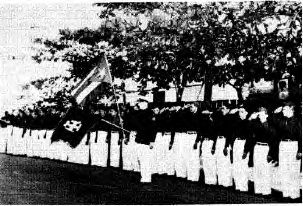
Cadets of the Republic, known in Spanish as Cadetes de la República, was the paramilitary wing of the Puerto Rican Nationalist Party in the twentieth century. The organization was also referred to as the Liberation Army of Puerto Rico(Ejército Libertador de Puerto Rico)

Tomás López de Victoria (1911–????) was a political activist and the Sub-Commander of the Cadets of the Republic. These cadets were the official youth organization within the Puerto Rican Nationalist Party. They were also known as the Ejército Libertador de Puerto Rico.

Irvin Flores was a political activist, member of the Puerto Rican Nationalist Party and an advocate of Puerto Rican independence. Flores was a leader of the Nationalist faction of Mayagüez, Puerto Rico during the Puerto Rican Nationalist Party revolts of the 1950s. On March 1, 1954, Flores together with fellow Nationalists Lolita Lebrón, Andrés Figueroa Cordero, and Rafael Cancel Miranda entered the United States Capitol building armed with automatic pistols and fired 30 shots. Five congressmen were wounded, however all the representatives survived and Flores, along with the other three members of his group were immediately arrested.
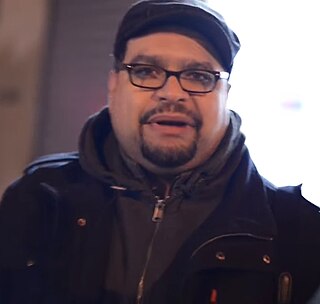
Dennis Flores is a Puerto Rican activist and "cop watcher" who works in New York City.